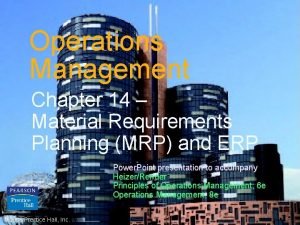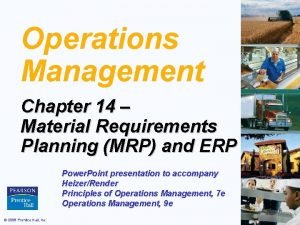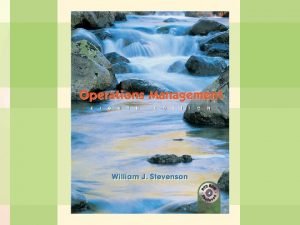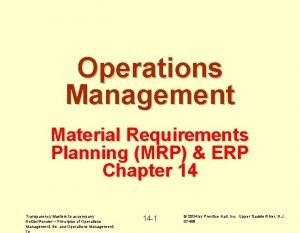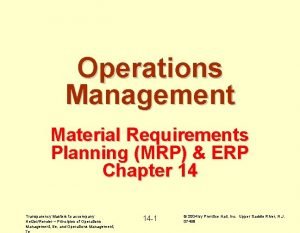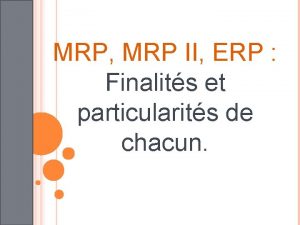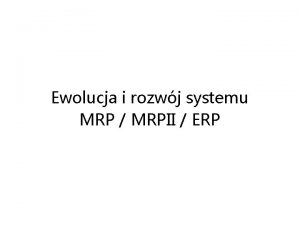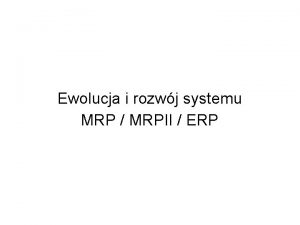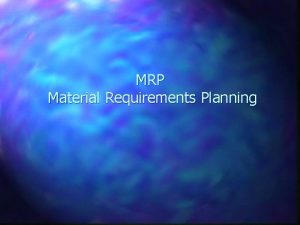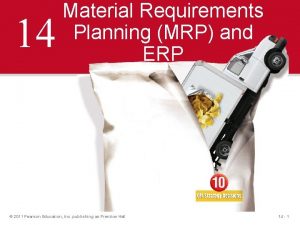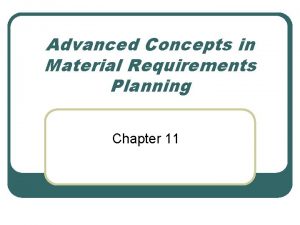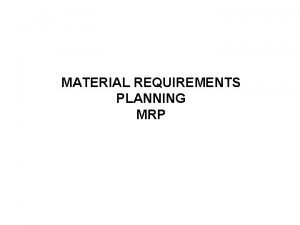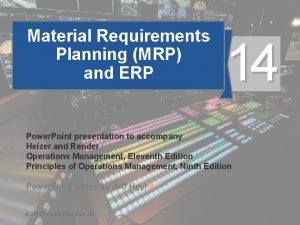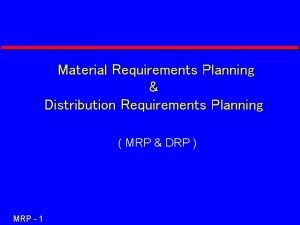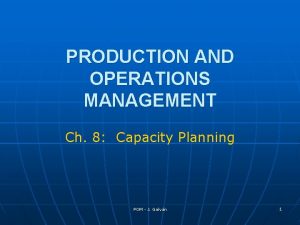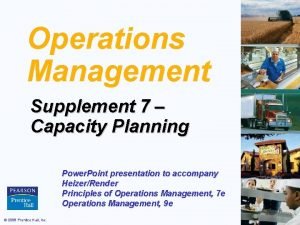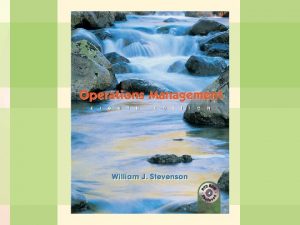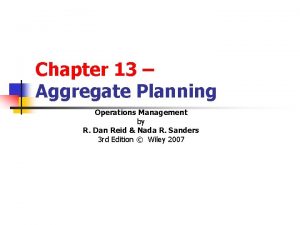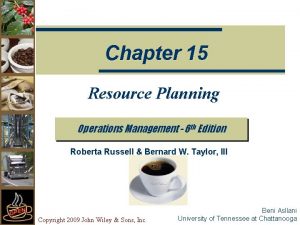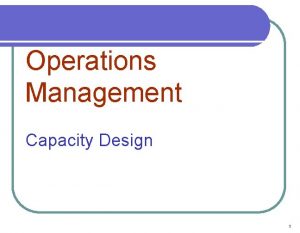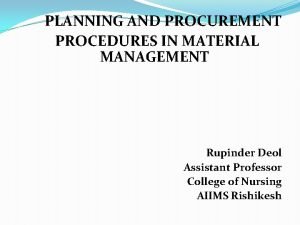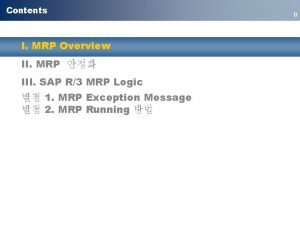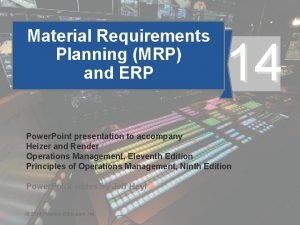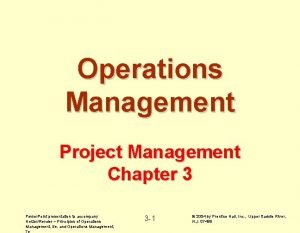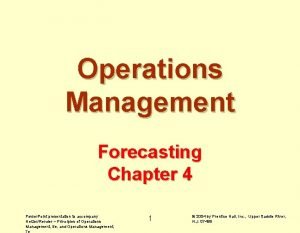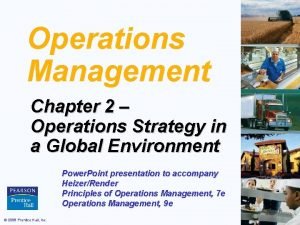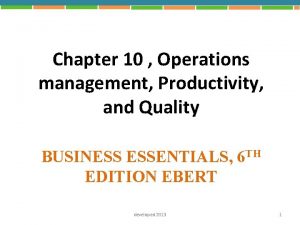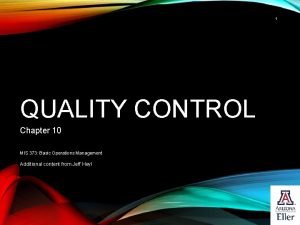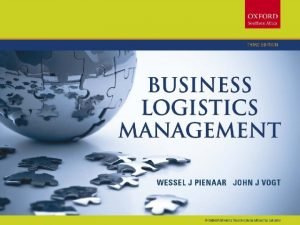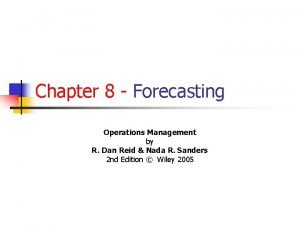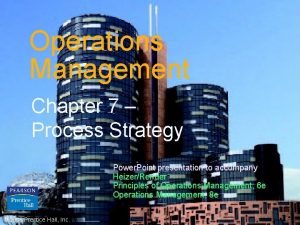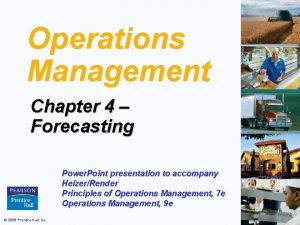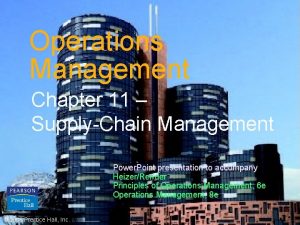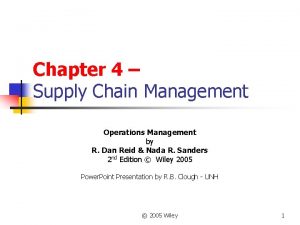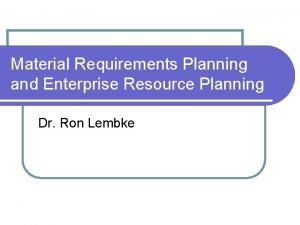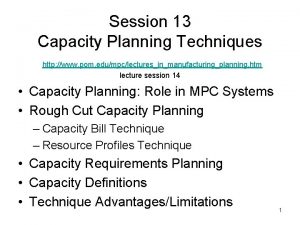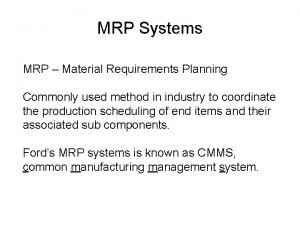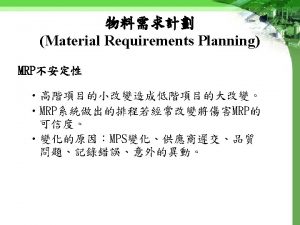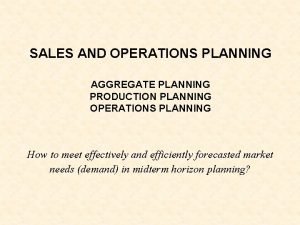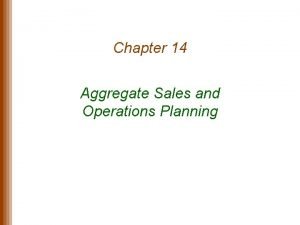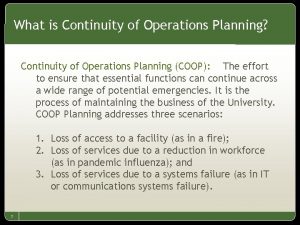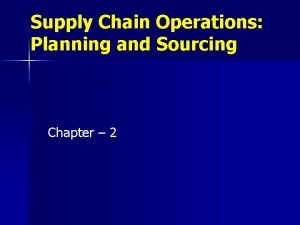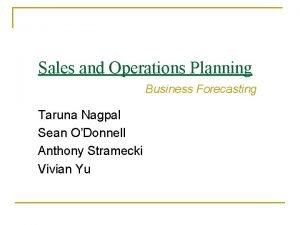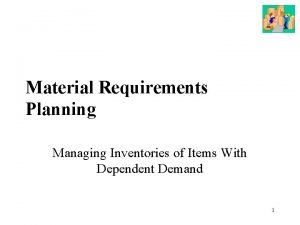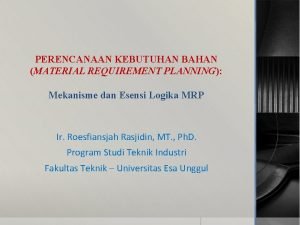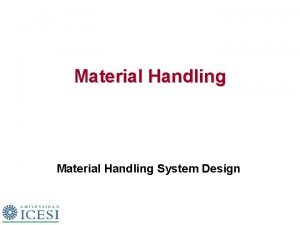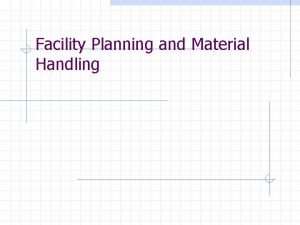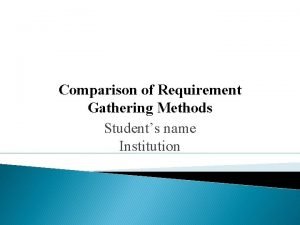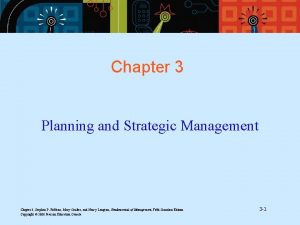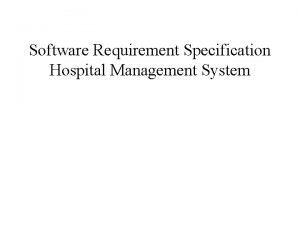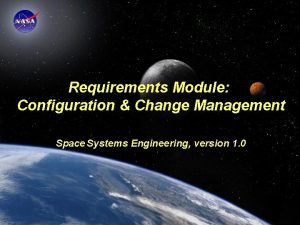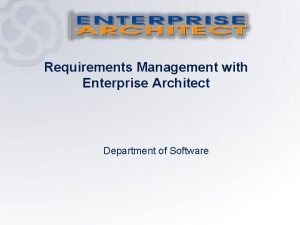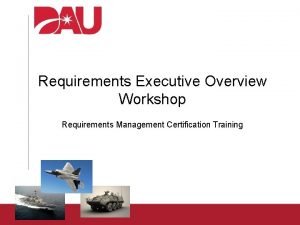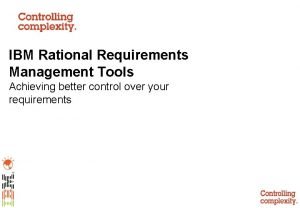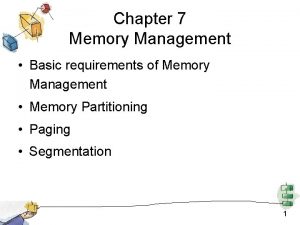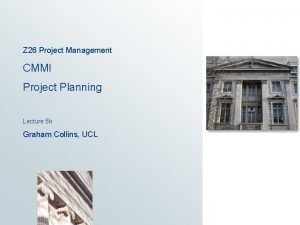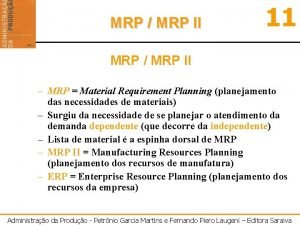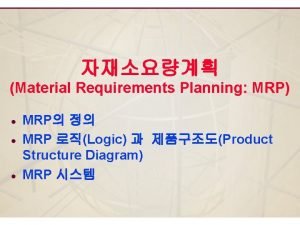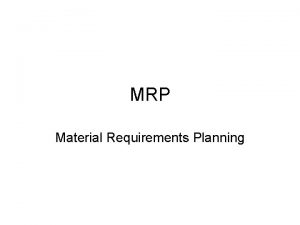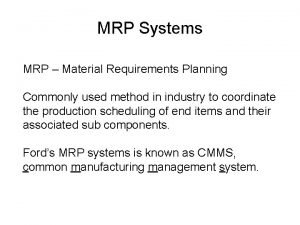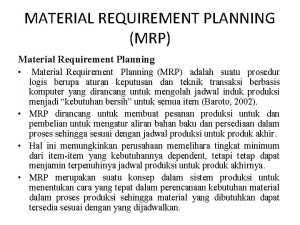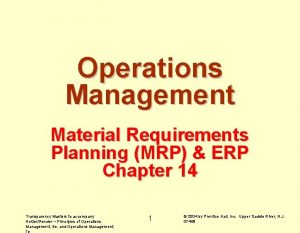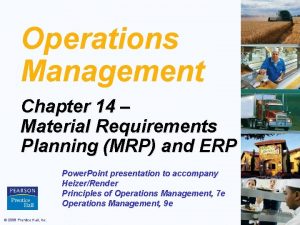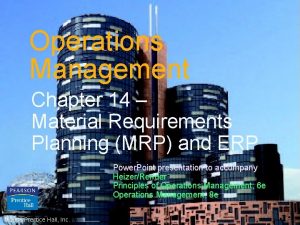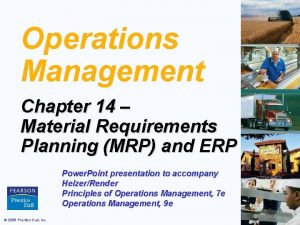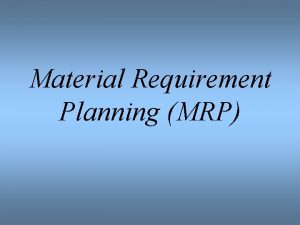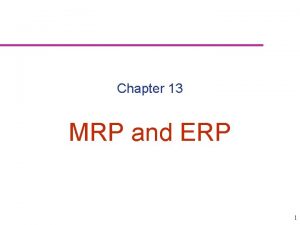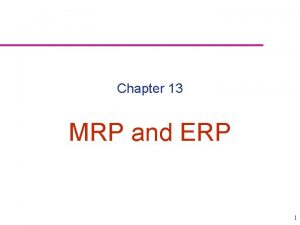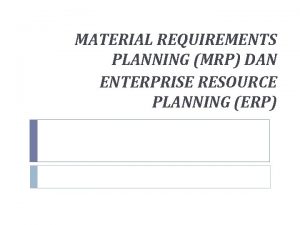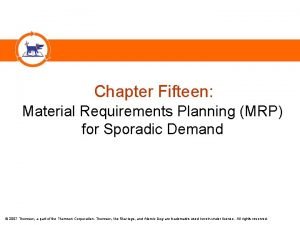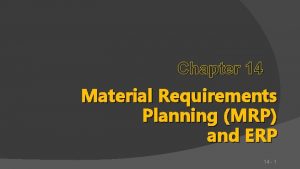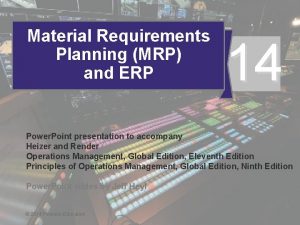Operations Management Chapter 14 Material Requirements Planning MRP
























































































- Slides: 88

Operations Management Chapter 14 – Material Requirements Planning (MRP) and ERP Power. Point presentation to accompany Heizer/Render Principles of Operations Management, 7 e Operations Management, 9 e © 2008 Prentice Hall, Inc. 14 –

Outline þ Global Company Profile: Wheeled Coach þ Dependent Demand þ Dependent Inventory Model Requirements þ Master Production Schedule þ Bills of Material þ Accurate Inventory Records þ Purchase Orders Outstanding þ Lead Times for Components © 2008 Prentice Hall, Inc. 14 – 2

Outline – Continued þ MRP Structure þ MRP Management þ MRP Dynamics þ MRP and JIT þ Lot-Sizing Techniques © 2008 Prentice Hall, Inc. 14 – 3

Outline – Continued þ Extensions of MRP þ Material Requirements Planning II (MRP II) þ Closed-Loop MRP þ Capacity Planning þ MRP In Services þ Distribution Resource Planning (DRP) © 2008 Prentice Hall, Inc. 14 – 4

Outline – Continued þ Enterprise Resource Planning (ERP) þ Advantages and Disadvantages of ERP Systems þ ERP in the Service Sector © 2008 Prentice Hall, Inc. 14 – 5

Learning Objectives When you complete this chapter you should be able to: 1. Develop a product structure 2. Build a gross requirements plan 3. Build a net requirements plan 4. Determine lot sizes for lot-forlot, EOQ, and PPB © 2008 Prentice Hall, Inc. 14 – 6

Learning Objectives When you complete this chapter you should be able to: 5. 6. Describe MRP II Describe closed-loop MRP 7. Describe ERP © 2008 Prentice Hall, Inc. 14 – 7

Wheeled Coach þ Largest manufacturer of ambulances in the world þ International competitor þ 12 major ambulance designs þ 18, 000 different inventory items þ 6, 000 manufactured parts þ 12, 000 purchased parts © 2008 Prentice Hall, Inc. 14 – 8

Wheeled Coach þ Four Key Tasks þ Material plan must meet both the requirements of the master schedule and the capabilities of the production facility þ Plan must be executed as designed þ Minimize inventory investment þ Maintain excellent record integrity © 2008 Prentice Hall, Inc. 14 – 9

Benefits of MRP 1. Better response to customer orders 2. Faster response to market changes 3. Improved utilization of facilities and labor 4. Reduced inventory levels © 2008 Prentice Hall, Inc. 14 – 10

Dependent Demand þ The demand for one item is related to the demand for another item þ Given a quantity for the end item, the demand for all parts and components can be calculated þ In general, used whenever a schedule can be established for an item þ MRP is the common technique © 2008 Prentice Hall, Inc. 14 – 11

Dependent Demand Effective use of dependent demand inventory models requires the following 1. 2. 3. 4. 5. © 2008 Prentice Hall, Inc. Master production schedule Specifications or bill of material Inventory availability Purchase orders outstanding Lead times 14 – 12

Master Production Schedule (MPS) þ þ Specifies what is to be made and when Must be in accordance with the aggregate production plan þ Inputs from financial plans, customer demand, engineering, supplier performance þ As the process moves from planning to execution, each step must be tested for feasibility þ The MPS is the result of the production planning process © 2008 Prentice Hall, Inc. 14 – 13

Master Production Schedule (MPS) þ MPS is established in terms of specific products þ Schedule must be followed for a reasonable length of time þ The MPS is quite often fixed or frozen in the near term part of the plan þ The MPS is a rolling schedule þ The MPS is a statement of what is to be produced, not a forecast of demand © 2008 Prentice Hall, Inc. 14 – 14

The Planning Process Production Capacity Inventory Marketing Customer demand Procurement Supplier performance Management Return on investment Capital Finance Cash flow Human resources Manpower planning Aggregate production plan Master production schedule Engineering Design completion Change production plan? Figure 14. 1 © 2008 Prentice Hall, Inc. 14 – 15

The Planning Process Master production schedule Change requirements? Change master production schedule? Material requirements plan Change capacity? Capacity requirements plan No Realistic? Yes Is capacity plan being met? Is execution meeting the plan? Execute capacity plans Execute material plans Figure 14. 1 © 2008 Prentice Hall, Inc. 14 – 16

Aggregate Production Plan Months Aggregate Production Plan (Shows the total quantity of amplifiers) Weeks Master Production Schedule (Shows the specific type and quantity of amplifier to be produced 240 -watt amplifier 150 -watt amplifier 75 -watt amplifier 1 January February 1, 500 1, 200 2 100 3 4 100 500 6 100 500 300 5 7 8 100 450 100 Figure 14. 2 © 2008 Prentice Hall, Inc. 14 –

Master Production Schedule (MPS) Can be expressed in any of the following terms: þ A customer order in a job shop (maketo-order) company þ Modules in a repetitive (assemble-toorder or forecast) company þ An end item in a continuous (stock-toforecast) company © 2008 Prentice Hall, Inc. 14 – 18

Focus for Different Process Strategies Make to Order (Process Focus) Number of end items (Product Focus) Schedule modules Schedule orders Number of inputs Examples: © 2008 Prentice Hall, Inc. Stock to Forecast Schedule finished product Typical focus of the master production schedule Figure 14. 3 Assemble to Order or Forecast (Repetitive) Print shop Machine shop Fine-dining restaurant Motorcycles Autos, TVs Fast-food restaurant Steel, Beer, Bread Lightbulbs Paper 14 – 19

MPS Examples For Nancy’s Specialty Foods Gross Requirements for Crabmeat Quiche Day Amount 6 50 7 8 100 9 47 10 60 11 12 110 13 75 14 and so on Gross Requirements for Spinach Quiche Day Amount 7 8 9 100 200 150 10 11 12 60 13 75 14 15 100 16 and so on Table 14. 1 © 2008 Prentice Hall, Inc. 14 – 20

Bills of Material þ List of components, ingredients, and materials needed to make product þ Provides product structure þ Items above given level are called parents þ Items below given level are called children © 2008 Prentice Hall, Inc. 14 – 21

BOM Example Level Product structure for “Awesome” (A) 0 A 1 2 3 12” Speaker kit w/ C(3) Std. amp-booster B(2) Std. 12” Speaker kit E(2) D(2) F(2) Std. 12” Speaker E(2) Packing box and installation kit of wire, bolts, and screws booster assembly G(1) D(2) Amp-booster 12” Speaker © 2008 Prentice Hall, Inc. 12” Speaker 14 – 22

BOM Example Level Product structure for “Awesome” (A) 0 A 1 2 3 D(2) Part B: 2 x number of As = (2)(50) = 100 12” Speaker 150 kit w/ C: 3 x number of As = (3)(50) BPart C(3) =Std. (2) Std. 12” Speaker kit amp-booster Part D: 2 x number of Bs + 2 x number of Fs = (2)(100) + (2)(300) = 800 Part E: E(2) 2 x number of Bs E(2) F(2) Std. 12” Speaker booster + 2 x number of Cs = (2)(100) + (2)(150) = assembly 500 Part F: 2 x Packing numberbox ofand Cs = (2)(150) = 300 Part G: 1 installation x numberkitofof. Fs = (1)(300) 300 wire, G(1) = D(2) bolts, and screws Amp-booster 12” Speaker © 2008 Prentice Hall, Inc. 12” Speaker 14 – 23

Bills of Material þ Modular Bills þ Modules are not final products but components that can be assembled into multiple end items þ Can significantly simplify planning and scheduling © 2008 Prentice Hall, Inc. 14 – 24

Bills of Material þ Planning Bills (Pseudo Bills) þ Created to assign an artificial parent to the BOM þ Used to group subassemblies to reduce the number of items planned and scheduled þ Used to create standard “kits” for production © 2008 Prentice Hall, Inc. 14 – 25

Bills of Material þ Phantom Bills þ Describe subassemblies that exist only temporarily þ Are part of another assembly and never go into inventory þ Low-Level Coding þ Item is coded at the lowest level at which it occurs þ BOMs are processed one level at a time © 2008 Prentice Hall, Inc. 14 – 26

Accurate Records þ Accurate inventory records are absolutely required for MRP (or any dependent demand system) to operate correctly þ Generally MRP systems require 99% accuracy þ Outstanding purchase orders must accurately reflect quantities and scheduled receipts © 2008 Prentice Hall, Inc. 14 – 27

Lead Times þ The time required to purchase, produce, or assemble an item þ For production – the sum of the order, wait, move, setup, store, and run times þ For purchased items – the time between the recognition of a need and the availability of the item for production © 2008 Prentice Hall, Inc. 14 – 28

Time-Phased Product Structure Must have D and E completed here so production can begin on B Start production of D 1 week D 2 weeks to produce B 2 weeks E A 2 weeks 1 week E 1 week 2 weeks G C 3 weeks F 1 week D | | | 1 2 3 © 2008 Prentice Hall, Inc. | | 4 5 Time in weeks | | | 6 7 8 Figure 14. 4 14 – 29

MRP Structure Data Files Output Reports BOM MRP by period report Master production schedule MRP by date report Lead times Planned order report (Item master file) Inventory data Purchasing data Material requirement planning programs (computer and software) Purchase advice Exception reports Order early or late or not needed Order quantity too small or too large Figure 14. 5 © 2008 Prentice Hall, Inc. 14 – 30

Determining Gross Requirements þ Starts with a production schedule for the end item – 50 units of Item A in week 8 þ Using the lead time for the item, determine the week in which the order should be released – a 1 week lead time means the order for 50 units should be released in week 7 þ This step is often called “lead time offset” or “time phasing” © 2008 Prentice Hall, Inc. 14 – 31

Determining Gross Requirements þ From the BOM, every Item A requires 2 Item Bs – 100 Item Bs are required in week 7 to satisfy the order release for Item A þ The lead time for the Item B is 2 weeks – release an order for 100 units of Item B in week 5 þ The timing and quantity for component requirements are determined by the order release of the parent(s) © 2008 Prentice Hall, Inc. 14 – 32

Determining Gross Requirements þ The process continues through the entire BOM one level at a time – often called “explosion” þ By processing the BOM by level, items with multiple parents are only processed once, saving time and resources and reducing confusion þ Low-level coding ensures that each item appears at only one level in the BOM © 2008 Prentice Hall, Inc. 14 – 33

Gross Requirements Plan 1 A. Required date Order release date B. Required date Order release date C. Required date Order release date E. Required date Order release date F. Required date Order release date D. Required date Order release date G. Required date Order release date 2 3 Week 4 5 6 7 50 100 150 200 300 300 600 300 200 150 8 Lead Time 50 1 week 2 weeks 3 weeks 1 week 2 weeks Table 14. 3 © 2008 Prentice Hall, Inc. 14 – 34

Net Requirements Plan © 2008 Prentice Hall, Inc. 14 – 35

Net Requirements Plan © 2008 Prentice Hall, Inc. 14 – 36

Determining Net Requirements þ Starts with a production schedule for the end item – 50 units of Item A in week 8 þ Because there are 10 Item As on hand, only 40 are actually required – (net requirement) = (gross requirement - onhand inventory) þ The planned order receipt for Item A in week 8 is 40 units – 40 = 50 - 10 © 2008 Prentice Hall, Inc. 14 – 37

Determining Net Requirements þ Following the lead time offset procedure, the planned order release for Item A is now 40 units in week 7 þ The gross requirement for Item B is now 80 units in week 7 þ There are 15 units of Item B on hand, so the net requirement is 65 units in week 7 þ A planned order receipt of 65 units in week 7 generates a planned order release of 65 units in week 5 © 2008 Prentice Hall, Inc. 14 – 38

Determining Net Requirements þ A planned order receipt of 65 units in week 7 generates a planned order release of 65 units in week 5 þ The on-hand inventory record for Item B is updated to reflect the use of the 15 items in inventory and shows no on-hand inventory in week 8 þ This is referred to as the Gross-to-Net calculation and is the third basic function of the MRP process © 2008 Prentice Hall, Inc. 14 – 39

Net Requirements Plan The logic of net requirements Gross Allocations requirements + Total requirements – On Scheduled + hand receipts Net = requirements Available inventory © 2008 Prentice Hall, Inc. 14 – 40

Gross Requirements Schedule Figure 14. 6 S A B B C Lead time = 4 for A Master schedule for A Periods 5 6 7 40 Periods Gross requirements: B © 2008 Prentice Hall, Inc. 8 9 10 11 50 15 1 2 10 40+10 =50 3 40 C Lead time = 6 for S Master schedule for S 8 9 10 11 12 13 40 4 50 5 20 6 20 7 15+30 =45 30 8 Master schedule for B sold directly 1 2 3 10 10 Therefore, these are the gross requirements for B 14 – 41

MRP Planning Sheet Figure 14. 7 © 2008 Prentice Hall, Inc. 14 – 42

Safety Stock þ BOMs, inventory records, purchase and production quantities may not be perfect þ Consideration of safety stock may be prudent þ Should be minimized and ultimately eliminated þ Typically built into projected onhand inventory © 2008 Prentice Hall, Inc. 14 – 43

MRP Management þ MRP is a dynamic system þ Facilitates replanning when changes occur þ System nervousness can result from too many changes þ Time fences put limits on replanning þ Pegging links each item to its parent allowing effective analysis of changes © 2008 Prentice Hall, Inc. 14 – 44

MRP and JIT þ MRP is a planning system that does not do detailed scheduling þ MRP requires fixed lead times which might actually vary with batch size þ JIT excels at rapidly moving small batches of material through the system © 2008 Prentice Hall, Inc. 14 – 45

Finite Capacity Scheduling þ MRP systems do not consider capacity during normal planning cycles þ Finite capacity scheduling (FCS) recognizes actual capacity limits þ By merging MRP and FCS, a finite schedule is created with feasible capacities which facilitates rapid material movement © 2008 Prentice Hall, Inc. 14 – 46

Small Bucket Approach 1. MRP “buckets” are reduced to daily or hourly þ The most common planning period (time bucket) for MRP systems is weekly 2. Planned receipts are used internally to sequence production 3. Inventory is moved through the plant on a JIT basis 4. Completed products are moved to finished goods inventory which reduces required quantities for subsequent planned orders 5. Back flushing based on the BOM is used to deduct inventory that was used in production © 2008 Prentice Hall, Inc. 14 – 47

Balanced Flow þ Used in repetitive operations þ MRP plans are executed using JIT techniques based on “pull” principles þ Flows are carefully balanced with small lot sizes © 2008 Prentice Hall, Inc. 14 – 48

Supermarket þ Items used by many products are held in a common area often called a supermarket þ Items are withdrawn as needed þ Inventory is maintained using JIT systems and procedures þ Common items are not planned by the MRP system © 2008 Prentice Hall, Inc. 14 –

Lot-Sizing Techniques þ Lot-for-lot techniques order just what is required for production based on net requirements þ May not always be feasible þ If setup costs are high, lot-for-lot can be expensive þ Economic order quantity (EOQ) þ EOQ expects a known constant demand MRP systems often deal with unknown and variable demand © 2008 Prentice Hall, Inc. 14 – 50

Lot-Sizing Techniques þ Part Period Balancing (PPB) looks at future orders to determine most economic lot size þ The Wagner-Whitin algorithm is a complex dynamic programming technique þ Assumes a finite time horizon þ Effective, but computationally burdensome © 2008 Prentice Hall, Inc. 14 – 51

Lot-for-Lot Example Gross requirements 1 2 3 4 5 6 7 8 9 10 35 30 40 0 10 40 30 55 35 0 0 0 0 0 30 40 0 10 40 30 55 30 40 10 40 30 30 55 40 30 Scheduled receipts Projected on hand Net requirements 35 Planned order receipts Planned order releases 30 40 10 30 55 Holding cost = $1/week; Setup cost = $100; Lead time = 1 week © 2008 Prentice Hall, Inc. 14 – 52

Lot-for-Lot Example No on-hand inventory is carried through the system Total holding cost = $0 1 2 3 4 5 6 7 8 9 10 Gross 30 40 this 0 10 30 There are seven 35 setups for item 40 in this plan requirements Total setup cost = 7 x $100 = $700 Scheduled 55 receipts Projected on hand Net requirements 35 35 0 0 0 0 0 30 40 0 10 40 30 55 30 40 10 40 30 30 55 40 30 Planned order receipts Planned order releases 30 40 10 30 55 Holding cost = $1/week; Setup cost = $100; Lead time = 1 week © 2008 Prentice Hall, Inc. 14 – 53

EOQ Lot Size Example Gross requirements 1 2 3 4 5 6 7 8 9 10 35 30 40 0 10 40 30 55 35 0 43 3 3 66 26 69 69 39 0 30 0 0 7 0 4 0 0 16 Scheduled receipts Projected on hand Net requirements 35 Planned order receipts Planned order releases 73 73 Holding cost = $1/week; Setup cost = $100; Lead time = 1 week Average weekly gross requirements = 27; EOQ = 73 units © 2008 Prentice Hall, Inc. 14 – 54

EOQ Lot Size Example Annual demand = 1, 404 Total cost = setup cost + holding cost 1 2 3 4 5 6 7 9 10 Total cost = (1, 404/73) x $100 + (73/2) x ($1 x 852 weeks) Gross cost = $3, 798 Total 35 30 40 0 10 40 30 55 requirements Cost for 10 weeks = $3, 798 x (10 weeks/52 weeks) = Scheduled $730 receipts Projected on hand Net requirements 35 35 0 0 0 0 0 30 0 0 7 0 4 0 0 16 Planned order receipts Planned order releases 73 73 Holding cost = $1/week; Setup cost = $100; Lead time = 1 week Average weekly gross requirements = 27; EOQ = 73 units © 2008 Prentice Hall, Inc. 14 – 55

PPB Example Gross requirements 1 2 3 4 5 6 7 8 9 10 35 30 40 0 10 40 30 55 Scheduled receipts Projected on hand 35 Net requirements Planned order receipts Planned order releases Holding cost = $1/week; Setup cost = $100; Lead time = 1 week EPP = 100 units © 2008 Prentice Hall, Inc. 14 – 56

PPB Example Trial Lot Size (cumulative net requirements) Periods Combined 2 2, 3, 4 Gross requirements 2, 3, 4, 5, 6 Scheduled 30 70 1 70 35 80 120 receipts Combine periods Projected on 35 hand 6 Net requirements 6, 7, 8 order Planned receipts 6, 7, 8, 9 Planned order Combine releases 10 40 70 70 100 Part Periods 0 2 40 =3 40 x 41 5 6 40 30 40 0 10 40 70 = 40 x 1 + 10 x 3 230 = 40 x 1 + 10 x 3 + 40 x 4 Setup Costs Holding Total 7 8 9 10 30 55 100 + 70 = 170 2 - 5 as this results in the Part Period closest to the EPP 0 30 = 30 x 1 + 0 x 2 120 = 30 x 1 + 30 x 3 100 + 120 = 220 periods 6 - 9 as this results in the Part Period closest to the EPP 0 100 + 0 = 100 Holding cost = $1 /week; $100; + 190 = 490 Total cost Setup cost = 300 55 EPP = 100 units © 2008 Prentice Hall, Inc. 14 – 57

PPB Example Gross requirements 1 2 3 4 5 6 7 8 9 10 35 30 40 0 10 40 30 55 35 0 50 10 10 0 60 30 30 0 0 0 40 0 55 Scheduled receipts Projected on hand Net requirements 35 Planned order receipts Planned order releases 80 80 100 55 55 Holding cost = $1/week; Setup cost = $100; Lead time = 1 week EPP = 100 units © 2008 Prentice Hall, Inc. 14 – 58

Lot-Sizing Summary For these three examples Lot-for-lot EOQ PPB $700 $730 $490 a d e d l e i y ve a h d l u o w n i t i h W 5 r 5 e 4 n $ f o Wag t s l co a t o t a h t i plan w © 2008 Prentice Hall, Inc. 14 – 59

Lot-Sizing Summary þ In theory, lot sizes should be recomputed whenever there is a lot size or order quantity change þ In practice, this results in system nervousness and instability þ Lot-for-lot should be used when low-cost JIT can be achieved © 2008 Prentice Hall, Inc. 14 – 60

Lot-Sizing Summary þ Lot sizes can be modified to allow for scrap, process constraints, and purchase lots þ Use lot-sizing with care as it can cause considerable distortion of requirements at lower levels of the BOM þ When setup costs are significant and demand is reasonably smooth, PPB, Wagner-Whitin, or EOQ should give reasonable results © 2008 Prentice Hall, Inc. 14 – 61

Extensions of MRP þ Closed-Loop MRP þ MRP system provides input to the capacity plan, MPS, and production planning process þ Capacity Planning þ MRP system generates a load report which details capacity requirements þ This is used to drive the capacity planning process þ Changes pass back through the MRP system for rescheduling © 2008 Prentice Hall, Inc. 14 – 62

Material Requirements Planning II þ Once an MRP system is in place, inventory data can be augmented by other useful information þ Labor hours þ Material costs þ Capital costs þ Virtually any resource þ System is generally called MRP II or Material Resource Planning © 2008 Prentice Hall, Inc. 14 – 63

Material Resource Planning Week 5 A. Units (lead time 1 week) B. Labor: 10 hours each C. Machine: 2 hours each D. Payable: $0 each B. Units (lead time 2 weeks, C. 2 each required) Labor: 10 hours each Machine: 2 hours each Payable: Raw material at $5 each C. Units (lead time 4 weeks, D. 3 each required) Labor: 2 hours each 600 Machine: 1 hour each 300 Payable: Raw material at $10 each 3, 000 6 7 2, 000 400 1, 000 8 100 1, 000 200 300 Table 14. 4 © 2008 Prentice Hall, Inc. 14 – 64

Closed-Loop MRP System Figure 14. 8 © 2008 Prentice Hall, Inc. 14 – 65

Closed-Loop MRP System Production plan No Priority Planning Capacity Planning Desired master production schedule Realistic? Resource planning First cut capacity Planning Yes Material requirements (detailed) Capacity requirements (detailed) Figure 14. 8 © 2008 Prentice Hall, Inc. 14 – 66

Closed-Loop MRP System Capacity Control Priority Control (detailed scheduling) (work center throughput) Dispatch list Input/output report No Is specific capacity adequate ? © 2008 Prentice Hall, Inc. Execution No Yes Execute the plan Is average capacity adequate ? Figure 14. 8 14 – 67

Resource Requirements Profile Capacity exceeded in periods 4 & 6 150 – 100 – Lot 1 Lot 2 50 – – Lot 11 Lot 6 Lot 3 1 2 Lot 7 Lot 9 Available capacity Lot 15 Lot 12 Lot 4 Lot 8 Lot 5 3 Lot 10 Lot 14 13 4 5 Period (a) 6 7 Lot 16 8 Standard labor hours 200 – Lot 6 “split” Lot 11 moved 150 – Available capacity Lot 6 100 – Lot 1 Lot 2 50 – – Lot 3 1 2 Lot 7 Lot 9 Lot 12 Lot 11 Lot 15 Lot 4 Lot 8 Lot 5 3 Lot 10 Lot 14 13 4 5 Period (b) 6 7 Lot 16 8 Figure 14. 9 © 2008 Prentice Hall, Inc. 14 – 68

Resource Requirements Profile Capacity exceeded in periods 4 & 6 150 – 100 – Lot 1 50 – – Lot 11 Lot 6 Lot 2 Lot 7 Lot 9 Available capacity Lot 12 Lot 4 Lot 10 Lot 14 13 1 Lot 15 Standard labor hours 200 – Lot 6 “split” Lot 11 moved 150 – Available capacity Lot 6 100 – Lot 1 50 – Lot 2 Lot 7 Lot 9 Lot 12 Lot 11 Lot 15 Lot 4 Lot 10 Lot 14 13 Lot Lot 11 and Lot It is also possible to split lots 6 and 16 16 Lot Lot 8 8 3 3 move them earlier in the schedule. This would 5 5 – problems 2 avoid 3 4 any 5 potential 6 7 8 1 2 with 3 late 4 5 orders 6 7 8 Period cost. but Period would increase inventory holding (a) (b) Figure 14. 9 © 2008 Prentice Hall, Inc. 14 – 69

Smoothing Tactics 1. Overlapping þ Sends part of the work to following operations before the entire lot is complete þ Reduces lead time 2. Operations splitting þ Sends the lot to two different machines for the same operation þ Shorter throughput time but increased setup costs 3. Order or lot splitting þ Breaking up the order into smaller lots and running part ahead of schedule © 2008 Prentice Hall, Inc. 14 – 70

MRP in Services þ Some services or service items are directly linked to demand for other services þ These can be treated as dependent demand services or items þ Restaurants þ Hospitals þ Hotels © 2008 Prentice Hall, Inc. 14 – 71

MRP in Services (a) PRODUCT STRUCTURE TREE Veal picante #10001 Helper one; Work Center #2 Figure 14. 10 © 2008 Prentice Hall, Inc. Cooked linguini #20002 Uncooked linguini #30004 Spinach #20004 Chef; Work Center #1 Prepared veal and sauce #20003 Sauce #30006 Asst. Chef; Work Center #3 Veal #30005 14 – 72

MRP in Services (b) BILL OF MATERIALS Part Number Description Quantity Unit of Measure Unit cost 10001 Veal picante 1 Serving — 20002 Cooked linguini 1 Serving — 20003 Prepared veal and sauce 1 Serving — 20004 Spinach 0. 1 Bag 30004 Uncooked linguini 0. 5 Pound — 30005 Veal 1 Serving 2. 15 30006 Sauce 1 Serving 0. 80 © 2008 Prentice Hall, Inc. 0. 94 14 – 73

MRP in Services (c) BILL OF LABOR FOR VEAL PICANTE Work Center Operation Labor Type Labor Hours Setup Time Run Time 1 Assemble dish Chef . 0069 . 0041 2 Cook linguini Helper one . 0005 . 0022 3 Cook veal and sauce Assistant Chef . 0125 . 0500 © 2008 Prentice Hall, Inc. 14 – 74

Distribution Resource Planning (DRP) Using dependent demand techniques through the supply chain þ Expected demand or sales forecasts become gross requirements þ Minimum levels of inventory to meet customer service levels þ Accurate lead times þ Definition of the distribution structure © 2008 Prentice Hall, Inc. 14 – 75

Enterprise Resource Planning (ERP) þ An extension of the MRP system to tie in customers and suppliers 1. Allows automation and integration of many business processes 2. Shares common data bases and business practices 3. Produces information in real time þ Coordinates business from supplier evaluation to customer invoicing © 2008 Prentice Hall, Inc. 14 – 76

Enterprise Resource Planning (ERP) þ ERP modules include þ Basic MRP þ Finance þ Human resources þ þ © 2008 Prentice Hall, Inc. Supply chain management (SCM) Customer relationship management (CRM) 14 – 77

ERP and MRP Figure 14. 11 © 2008 Prentice Hall, Inc. 14 – 78

ERP and MRP Customer Relationship Management Invoicing Sales Order (order entry, product configuration, sales management) Shipping Distributors, retailers, and end users Figure 14. 11 © 2008 Prentice Hall, Inc. 14 – 79

ERP and MRP Master Production Schedule Inventory Management Bills of Material MRP Work Orders Purchasing and Lead Times Table 13. 6 Figure 14. 11 © 2008 Prentice Hall, Inc. Routings and Lead Times 14 – 80

ERP and MRP Supply Chain Management Vendor Communication (schedules, EDI, advanced shipping notice, e-commerce, etc. ) Figure 14. 11 © 2008 Prentice Hall, Inc. 14 – 81

ERP and MRP Finance/ Accounting Accounts Receivable General Ledger Accounts Payable Payroll Figure Table 14. 11 13. 6 © 2008 Prentice Hall, Inc. 14 – 82

Enterprise Resource Planning (ERP) þ ERP can be highly customized to meet specific business requirements þ Enterprise application integration software (EAI) allows ERP systems to be integrated with þ Warehouse management þ Logistics þ Electronic catalogs þ Quality management © 2008 Prentice Hall, Inc. 14 – 83

Enterprise Resource Planning (ERP) þ ERP systems have the potential to þ þ Reduce transaction costs Increase the speed and accuracy of information þ Facilitates a strategic emphasis on JIT systems and integration © 2008 Prentice Hall, Inc. 14 – 84

Advantages of ERP Systems 1. Provides integration of the supply chain, production, and administration 2. Creates commonality of databases 3. Can incorporate improved best processes 4. Increases communication and collaboration between business units and sites 5. Has an off-the-shelf software database 6. May provide a strategic advantage © 2008 Prentice Hall, Inc. 14 – 85

Disadvantages of ERP Systems 1. Is very expensive to purchase and even more so to customize 2. Implementation may require major changes in the company and its processes 3. Is so complex that many companies cannot adjust to it 4. Involves an ongoing, possibly never completed, process for implementation 5. Expertise is limited with ongoing staffing problems © 2008 Prentice Hall, Inc. 14 – 86

SAP’s ERP Modules Figure 14. 12 Cash to Cash Covers all financial related activity: Accounts receivable General ledger Accounts payable Treasury Promote to Deliver Covers front-end customer-oriented activities: Marketing Quote and order processing Transportation Documentation and labeling After sales service Warranty and guarantees Design to Manufacture Covers internal production activities: Design Shop floor engineering reporting Production Contract/project engineering management Plant Subcontractor maintenance management Recruit to Hire Covers all HR- and payroll-oriented activity: Time and attendance Payroll Travel and expenses Cash management Asset management Procure to Pay Covers sourcing activities: Vendor sourcing Purchase requisitioning Purchase ordering Purchase contracts Inbound logistics Supplier invoicing/ matching Supplier payment/ settlement Supplier performance Dock to Dispatch Covers internal inventory management: Warehousing Forecasting Distribution planning Replenishment planning © 2008 Prentice Hall, Inc. Physical inventory Material handling 14 – 87

ERP in the Service Sector þ ERP systems have been developed for health care, government, retail stores, hotels, and financial services þ Also called efficient consumer response (ECR) systems þ Objective is to tie sales to buying, inventory, logistics, and production © 2008 Prentice Hall, Inc. 14 – 88
 Mrp in operations management
Mrp in operations management Distribution requirements planning (drp)
Distribution requirements planning (drp) Mpr erp
Mpr erp Mrp and erp operations management
Mrp and erp operations management Mrp and erp operations management
Mrp and erp operations management Mrp mrp ii erp
Mrp mrp ii erp Mrp
Mrp Mrp mrp ii
Mrp mrp ii Material requirements planning
Material requirements planning Material requirements planning
Material requirements planning Material requirements planning concepts
Material requirements planning concepts Vertical
Vertical Erp requirements planning
Erp requirements planning Distribution requirements planning
Distribution requirements planning Chapter 12 inventory management
Chapter 12 inventory management System capacity definition in operations management
System capacity definition in operations management Leading demand with incremental expansion
Leading demand with incremental expansion Location planning and analysis
Location planning and analysis Retail operations strategy
Retail operations strategy Level chase and hybrid strategies
Level chase and hybrid strategies Location planning and analysis
Location planning and analysis Resource planning in operations management
Resource planning in operations management What is capacity design in operations management
What is capacity design in operations management Material management planning and procurement
Material management planning and procurement Mrp elements
Mrp elements Ideal properties of restorative material
Ideal properties of restorative material Material resource planning
Material resource planning Quality management in operations management
Quality management in operations management Operations management with total quality management book
Operations management with total quality management book Geometric symbols and their meanings
Geometric symbols and their meanings Idle time meaning in cost accounting
Idle time meaning in cost accounting Example of pop culture
Example of pop culture Non material culture examples
Non material culture examples Non material culture examples
Non material culture examples Harmful or useful
Harmful or useful Operation management chapter 3
Operation management chapter 3 Operations management chapter 4 forecasting solutions
Operations management chapter 4 forecasting solutions Operations management chapter 2
Operations management chapter 2 Operations management objectives
Operations management objectives Chapter 3 operations management
Chapter 3 operations management Operations management chapter 10
Operations management chapter 10 Asq control chart
Asq control chart Chapter 8 operations management
Chapter 8 operations management Operations management chapter 3 forecasting solutions
Operations management chapter 3 forecasting solutions Cross over charts
Cross over charts Associative forecasting example
Associative forecasting example Chapter 11 operations management
Chapter 11 operations management Human resource and job design in operations management
Human resource and job design in operations management 4 flows of supply chain
4 flows of supply chain Operation management chapter 2
Operation management chapter 2 Wedding planning requirements
Wedding planning requirements Enterprise requirements planning
Enterprise requirements planning Capacity requirements planning
Capacity requirements planning Capacity requirements planning
Capacity requirements planning Capacity requirements planning
Capacity requirements planning Sales & operations planning in sap
Sales & operations planning in sap Aggregate sales and operations planning
Aggregate sales and operations planning Aggregate planning excel solver
Aggregate planning excel solver Continuity of operations planning (coop)
Continuity of operations planning (coop) Supply chain operations planning
Supply chain operations planning Rough cut capacity planning example
Rough cut capacity planning example Pegging report
Pegging report Material requirement planning calculation example
Material requirement planning calculation example Contoh material requirement planning
Contoh material requirement planning Handling system design
Handling system design Material handling and facilities planning
Material handling and facilities planning Material requirement planning advantages and disadvantages
Material requirement planning advantages and disadvantages Management chapter 5 planning and decision making
Management chapter 5 planning and decision making Chapter 3 planning
Chapter 3 planning Chapter 16 money management and financial planning
Chapter 16 money management and financial planning What are some characteristics of a wise money manager
What are some characteristics of a wise money manager Options-based planning
Options-based planning Strategic planning vs tactical planning
Strategic planning vs tactical planning Planning balance sheet in urban planning
Planning balance sheet in urban planning Role segmentation workforce planning
Role segmentation workforce planning Proactive planning and reactive planning
Proactive planning and reactive planning Aggregate planning is capacity planning for:
Aggregate planning is capacity planning for: Short medium and long term planning in education
Short medium and long term planning in education Language policy and planning ppt
Language policy and planning ppt Aggregate capacity planning
Aggregate capacity planning Examples of aggregate planning
Examples of aggregate planning Sequence diagram of hospital management system
Sequence diagram of hospital management system Spacecraft requirements management
Spacecraft requirements management Requirements management enterprise architect
Requirements management enterprise architect Requirements management training
Requirements management training Rational requirements composer
Rational requirements composer What are the requirements of memory management
What are the requirements of memory management Cmmi project management
Cmmi project management Gym database management system
Gym database management system
